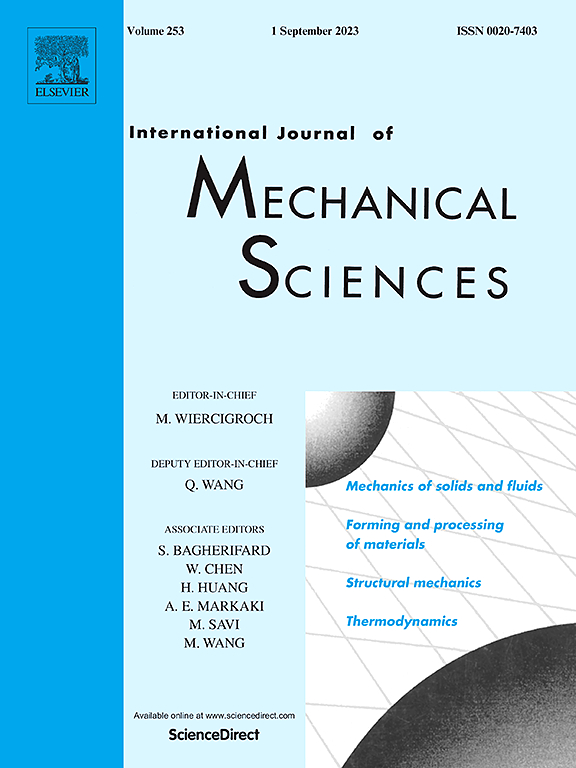Efficient dataset generation for inverse design of micro-perforated sonic crystals
IF 7.1
1区 工程技术
Q1 ENGINEERING, MECHANICAL
International Journal of Mechanical Sciences
Pub Date : 2025-03-25
DOI:10.1016/j.ijmecsci.2025.110190
引用次数: 0
Abstract
Micro-perforated panels (MPPs) used as scatterers in sonic crystals (SCs) provide design flexibility for acoustic applications. Achieving the sound attenuation within a specified frequency range requires an inverse design procedure that refines the geometric parameters of MPP-SCs. Although data-driven methods show considerable promise for solving such inverse design problems, the generation of a large, well-labeled dataset of MPP-SCs remains computationally intensive, posing a critical bottleneck in deep learning-assisted design of periodic structures. To evaluate the acoustic attenuation properties of MPP-SCs, their complex band structures are computed using the Finite Element Method (FEM). In order to enhance computational efficiency, an Interpolated Bloch Mode Synthesis (Interpolated BMS) method is developed within the FEM framework. This method integrates conventional BMS with the matrix interpolation technique. Specifically, the Craig-Bampton method is employed to reduce interior degrees of freedom (DOFs), while a B-spline-based approach is proposed for reducing boundary DOFs. Both steps decrease the dimensionality of the eigenvalue problem involved in calculating the complex band structure, thereby reducing the computational time from 14.86 s to 1.11 s without sacrificing numerical accuracy. Subsequently, matrix interpolation is applied to estimate the reduced global matrices, thereby eliminating the need for re-meshing and re-assembling the matrices when the geometric parameters of the MPP-SCs are adjusted. As a result, the efficiency of training sample generation is enhanced by a factor of 14.4 compared to commercial software. The dataset generated by the proposed method is then utilized to determine the geometric parameters of the MPP-SCs through either meta-heuristic algorithms or a conditional generative neural network. Experiments are also conducted to verify the numerical results and the inverse design results.

微穿孔声波晶体反设计的高效数据集生成
微穿孔板(mpp)作为声波晶体(sc)中的散射体,为声学应用提供了设计灵活性。实现特定频率范围内的声音衰减需要一个逆向设计过程,以细化mpp - sc的几何参数。尽管数据驱动的方法在解决此类逆设计问题方面显示出相当大的希望,但生成大型、标记良好的MPP-SCs数据集仍然需要大量的计算,这对周期结构的深度学习辅助设计构成了关键瓶颈。为了评价MPP-SCs的声衰减性能,采用有限元法对其复杂带结构进行了计算。为了提高计算效率,在有限元框架内提出了插值布洛赫模态综合(Interpolated BMS)方法。该方法将传统的BMS与矩阵插值技术相结合。具体而言,采用Craig-Bampton方法降低内部自由度,提出基于b样条的方法降低边界自由度。这两个步骤都降低了计算复杂波段结构所涉及的特征值问题的维数,从而在不牺牲数值精度的情况下将计算时间从14.86 s减少到1.11 s。随后,采用矩阵插值方法估计约简后的全局矩阵,从而消除了调整MPP-SCs几何参数时重新网格划分和重新组装矩阵的需要。与商业软件相比,训练样本生成的效率提高了14.4倍。然后利用该方法生成的数据集,通过元启发式算法或条件生成神经网络确定MPP-SCs的几何参数。通过实验验证了数值结果和反设计结果。
本文章由计算机程序翻译,如有差异,请以英文原文为准。
求助全文
约1分钟内获得全文
求助全文
来源期刊

International Journal of Mechanical Sciences
工程技术-工程:机械
CiteScore
12.80
自引率
17.80%
发文量
769
审稿时长
19 days
期刊介绍:
The International Journal of Mechanical Sciences (IJMS) serves as a global platform for the publication and dissemination of original research that contributes to a deeper scientific understanding of the fundamental disciplines within mechanical, civil, and material engineering.
The primary focus of IJMS is to showcase innovative and ground-breaking work that utilizes analytical and computational modeling techniques, such as Finite Element Method (FEM), Boundary Element Method (BEM), and mesh-free methods, among others. These modeling methods are applied to diverse fields including rigid-body mechanics (e.g., dynamics, vibration, stability), structural mechanics, metal forming, advanced materials (e.g., metals, composites, cellular, smart) behavior and applications, impact mechanics, strain localization, and other nonlinear effects (e.g., large deflections, plasticity, fracture).
Additionally, IJMS covers the realms of fluid mechanics (both external and internal flows), tribology, thermodynamics, and materials processing. These subjects collectively form the core of the journal's content.
In summary, IJMS provides a prestigious platform for researchers to present their original contributions, shedding light on analytical and computational modeling methods in various areas of mechanical engineering, as well as exploring the behavior and application of advanced materials, fluid mechanics, thermodynamics, and materials processing.
 求助内容:
求助内容: 应助结果提醒方式:
应助结果提醒方式:


